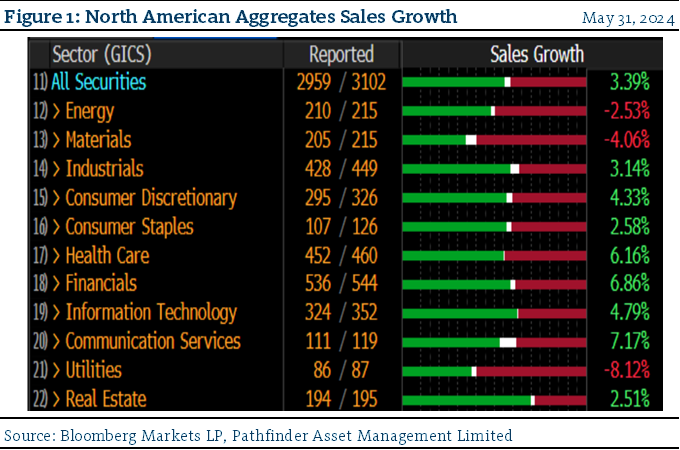First Quarter Earnings Season
As regular readers of the Investment Outlook know, our writing follows the calendar of quarterly earnings reports. The companies that we invest in report financial data and management commentary on a regular basis. This is colloquially called “earnings season”. It is an important part of our investment process because we can check-in on the progress of the companies that we own, as well as management’s expectations for the future of their business operations. Internally, we informally declare the “end-of-earnings season” when the results of the Canadian banks are published, and the last bank reported yesterday (Royal Bank of Canada RY:CN). In the Canadian banking sector, we continued to see strong results in capital markets and wealth management as market conditions and activity improved. However, there is continued pressure on the credit quality of borrowers, namely Canadian retail consumers, US transportation companies and various commercial real estate projects. This has caused the banks to recognize elevated provisional charges. The difference in each bank’s borrower profiles drove dispersion in earnings. We think the Canadian Banks are generally good businesses but we are generally concerned with overall debt levels and the potential deterioration of credit quality of their customers. Consequently, over the last several months, we have reduced our exposure to this sector.
Regular readers will recognize the aggregate sales data for North American companies noted in Figure 1.
- So far, 2,959 companies or 95.3% of North American companies have reported somewhat mixed results. In the last few quarters, most sectors have had positive sales growth, so this quarter is historically somewhat “more normal”.
- Sales accelerated again to the strongest in a year. We don’t focus on earnings for this metric but note that they were very good as well. Also, forward sales expectations are trending close to 5% year on year, which is very constructive.

“This means that” we continue to have a positive view on the North American economy (mostly due to the US). The data looks constructive, and generally we did not see anything from the quarterly earnings season in the companies that we own and follow that caused us any type of macro or broad concern. We remain committed to our process.
National Instrument 31-103 requires registered firms to disclose information that a reasonable investor would expect to know, including any material conflicts with the firm or its representatives. Doug Johnson and/or Pathfinder Asset Management Limited are an insider of companies periodically mentioned in this report. Please visit www.paml.ca for full disclosures.
Changes in Leverage. We are increasing the asset ceiling to 2.0 times the market value of equity for Pathfinder International Fund and Pathfinder Conviction Fund to be consistent with Pathfinder Partners’ Fund and Pathfinder Resource Fund.
*All returns are time weighted and net of investment management fees. Returns from the Pathfinder Partners’ Fund and Partners’ Real Return Plus Fund are presented based on the masters series of each fund. The Pathfinder Core: Equity Portfolio and The Pathfinder Core: High Income Portfolio are live accounts. These are actual accounts owned by the Pathfinder Chairman (Equity) and client (High Income) which contain no legacy positions, cash flows or other Pathfinder investment mandates or products. Monthly inception dates for each fund and portfolio are as follows: Pathfinder Core: Equity Portfolio (January 2011), Pathfinder Core: High Income Portfolio (October 2012) Partners’ Fund (April 2011), Partners’ Real Return Plus Fund (April, 2013), and Partners’ Core Plus Fund (November 2014).
Pathfinder Asset Management Limited (PAML) and its affiliates may collectively beneficially own in excess of 10% of one or more classes of the issued and outstanding equity securities mentioned in this newsletter. This publication is intended only to convey information. It is not to be construed as an investment guide or as an offer or solicitation of an offer to buy or sell any of the securities mentioned in it. The author has taken all usual and reasonable precautions to determine that the information contained in this publication has been obtained from sources believed to be reliable and that the procedures used to summarize and analyze such information are based on approved practices and principles in the investment industry. However, the market forces underlying investment value are subject to sudden and dramatic changes and data availability varies from one moment to the next. Consequently, neither the author nor PAML can make any warranty as to the accuracy or completeness of information, analysis or views contained in this publication or their usefulness or suitability in any particular circumstance. You should not undertake any investment or portfolio assessment or other transaction on the basis of this publication, but should first consult your portfolio manager, who can assess all relevant particulars of any proposed investment or transaction. PAML and the author accept no liability of any kind whatsoever or any damages or losses incurred by you as a result of reliance upon or use of this publication.